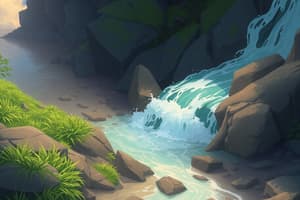Podcast
Questions and Answers
What factor contributes to increased infiltration of water in low lying ground?
What factor contributes to increased infiltration of water in low lying ground?
- Sloped terrain
- Short contact time with dirt
- Long contact time with dirt (correct)
- Fast rainfall
How does vegetation affect the infiltration rate?
How does vegetation affect the infiltration rate?
- Blocks water from seeping into the soil
- Creates impermeable layers on the ground
- Increases infiltration rate (correct)
- Decreases infiltration rate
Why does rain falling slowly enhance infiltration?
Why does rain falling slowly enhance infiltration?
- Decreases soil porosity
- Causes soil erosion
- Gives time for water to infiltrate further down (correct)
- Allows water to evaporate faster
Which material allows almost no infiltration of water?
Which material allows almost no infiltration of water?
Why does limestone have high permeability?
Why does limestone have high permeability?
What property of sand contributes to easy water infiltration?
What property of sand contributes to easy water infiltration?
Why does clay have low permeability despite having high porosity?
Why does clay have low permeability despite having high porosity?
In what way does vegetation aid in increasing infiltration?
In what way does vegetation aid in increasing infiltration?
What characteristic makes sand highly permeable?
What characteristic makes sand highly permeable?
Why is limestone able to hold large amounts of water?
Why is limestone able to hold large amounts of water?
Why does low lying ground increase the infiltration of water?
Why does low lying ground increase the infiltration of water?
What effect does decaying organic matter have on infiltration rate?
What effect does decaying organic matter have on infiltration rate?
Why does sand allow for easy water infiltration?
Why does sand allow for easy water infiltration?
What characteristic of clay contributes to its low permeability?
What characteristic of clay contributes to its low permeability?
How does limestone differ from granite in terms of water infiltration?
How does limestone differ from granite in terms of water infiltration?
What property of low lying ground contributes to increased water infiltration?
What property of low lying ground contributes to increased water infiltration?
In what way does vegetation increase infiltration rate?
In what way does vegetation increase infiltration rate?
What effect does rain falling slowly have on water infiltration?
What effect does rain falling slowly have on water infiltration?
Why is sand highly permeable compared to other materials?
Why is sand highly permeable compared to other materials?
Flashcards are hidden until you start studying
Study Notes
Low Lying Ground and Infiltration
- Low lying ground experiences increased water infiltration due to the prolonged contact time of water with the soil surface. This allows for more time for water to seep into the soil.
Vegetation and Infiltration
- Vegetation increases infiltration by acting as a barrier, slowing down surface runoff and allowing more water to enter the ground.
- Roots create pathways for water to seep into the soil.
- The decomposition of leaves and other organic matter enhances soil structure, increasing the rate of infiltration.
Rain Rate and Infiltration
- Slow rain enhances infiltration because it allows more time for water to be absorbed into the soil. This reduces surface runoff and promotes deeper penetration.
Material Properties
- Limestone: Its interconnected pores and fractures allow for high permeability, enabling easy water flow through the rock.
- Sand: The large pore spaces between sand particles contribute to high permeability, facilitating rapid water infiltration.
- Clay: Despite its high porosity, clay has a low permeability due to its small pore size and tightly packed structure. This restricts the movement of water through the soil.
- Granite: Granite is a highly impermeable material, meaning it resists water infiltration. This is because granite has very few pores or cracks for water to flow through.
Other Factors Affecting Infiltration
- Decaying Organic Matter: Decomposed organic matter improves soil structure, creating more space for water to infiltrate.
Studying That Suits You
Use AI to generate personalized quizzes and flashcards to suit your learning preferences.




